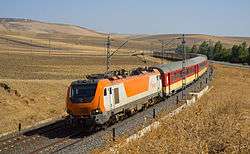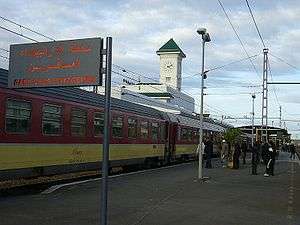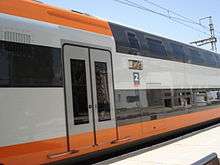ONCF
| Reporting mark | ONCF, ONCFM |
|---|---|
| Locale | Morocco |
| Dates of operation | 1963–present |
| Predecessor | Compagnie des chemins de Fer du Maroc ("CFM"); Compagnie franco-espagnole du chemin de fer de Tanger à Fès ("TF") |
| Track gauge | 1,435 mm (4 ft 8 1⁄2 in) standard gauge |
| Length | 2,110 km |
| Headquarters | 8, rue Abderrahmane El Ghafiki, Rabat - Agdal |
- See also Rail transport in Morocco
ONCF or ONCFM (from French: Office Nationale des Chemins de Fer du Maroc; Arabic: المكتب الوطني للسكك الحديدية Al-Maktab al-Waṭaniy lil-Sikak al-Ḥadīdiyyah; Moroccan National Railways Office) is Morocco's national railway operator. The Office employs around 7,845 employees[1] and has a network of 2,110 km, all 1,435 mm (4 ft 8 1⁄2 in) standard gauge of which 1,300 km is electrified (2015).[2]
History
ONCF was created January 1, 1963 as a merger of:
- Railways of Morocco (CFM) (French Compagnie des chemins de fer du Maroc)
- Railway of Eastern Morocco (CMO) (French Compagnie du chemin de fer du Maroc oriental)
- Franco-Spanish company of Tanger-Fès (TF) (French Compagnie franco-espagnole du Tanger-Fès)
- Mediterranean-Niger-Railway (MN) (French Chemins de Fer de la Méditerranée au Niger)
The railways has been state-owned since formation in 1963. Plans were made in 2007 to re-form ONCF into a limited compancy to be called SMCF,[3] but this hasn't materialized by the planned deadline in 2012.
Network

The network has a north-south track from Tangier via Rabat and Casablanca to Marrakech. This line connects all major cities along or close to the Atlantic coast. In September 2012, ONCF started upgrading the Casablanca-Kenitra main line to improve capacity.[4]
The other main link is the Northern East to West link from Oujda via Fes and Meknes to Rabat connecting to the N-S tracks in Kenitra.
For the (main) destinations where there is no trainservice (yet) the ONCF operates their own bus-company Supratours offering connecting bus-services from the nearest railway station to places like Agadir, Tétouan or Essaouira[5][6]
Extensions
A major investment program upgrades and extends the network. In 2009, a branch-line of the E-W link was completed, running from Taourirt for 100 km to Nador. This track runs down from the Rif mountains to sealevel at Nador. Most of the route from Taourirt follows the same route as the current national road. The tracks through Nador are underground and after Nador Ville the track continues to the Nador Port in Bin Anşār above ground again. This new branch-line is used for both passenger and freight trains with several passenger trains serving Fez, Rabat to Casablanca or to Tanger. There are 6 trains per day: some demanding change at Taourirt wye - others provide direct services up to Casablanca. The night-train (dep. 19:47 from Nador) doesn't even stop at Taourirt[7] and thus doesn't have to change travel-direction.
Another project completed in 2010 is a short-cut between Rabat and Tangier. When completed trains could run directly to Rabat and Casablanca without having to use the longer route via Sidi Kasim. Also in the north a new track is built between Tanger and Ras R'Mel.
Other routes under construction are:
- Casablanca to El-Jadida
- Bypass via Meknes, on the Rabat-Fes route
Not yet under construction, but planned are:
- Marrakech - Agadir, and then an extension further south to Laâyoune
- Oued Zem - Beni Mellal
The most important project is the development of a "high-speed link" (TGV) from Tangier via Rabat and Casablanca to Marrakech. The main contractor of this project is French company Alstom. The French president Nicolas Sarkozy was guest on 29 September 2011 when the actual construction of the line started. The first phase of the project is expected to be completed in 2012[8]
Freight only
Oujda railway station is the last station for passengers on the East-West link. The lines south of Oudja are for freight only and until the passenger-service starts the link Tanger-Tanger MED is also only operated for freight: mainly for the Renault factory at the port[9]
Towns served by railways
Railway links to adjacent countries
- There was a link to Algeria, but the border is now closed.
- Western Sahara: Via the proposed network-extension from Marrakech via Guelmim to El Aaiún would connect Morocco to the Western Sahara. Currently ONCF daughter-company Supratours operate bus-routes from Marrakesh to Western-Sahara such as Tan-Tan or El Aaiún.[5] Morocco claims Western Sahara as part of Morocco and thus as national routes.
- Melilla, Spain - train terminates at Nador Port, within walking distance of Melilla.
Services
The company makes a difference between the long-distance "Grandes Lignes", high-speed shuttle trains between Rabat and Casablanca, Urban transport in the Casablanca region and the "train by road" via daughter-company Supratours[10]
On the mainline (Grand Lignes) several trains are operated per day. In the first class all chairs are assigned seats. On three main routes the ONCF operate special night trains with either full beds in private rooms of couchettes. On the Oujda-Casablanca route they run a "hotel train" which only offeres beds and couchettes, no seats. These "Voyage de Nuit" is available on:[11]
- Casablanca-Oujda via Rabat, Sale, Fes and Taourirt: Train – Hôtel : Dep. Casablanca: 21:15 Arriving Oujda at 07:00
- Oujda-Casablanca, Departure: 21:00, Taourirt 22:43, Fes: 03:00 Rabat: 06:15, Casablanca: 07:15
- Marrakech-Tangier via Casablanca, Rabat, Kenitra: Departure: 21:00, Casa: 0:45, Rabat: 1:57, Tanger: 07:25
- Tangier-Marrakech: Tanger:21:05, Kenitra: 2:35, Rabat: 3:15, Casablanca: 4:30, Marrakech: 08:05
- Casablanca - Nador:[12] Departure: 19:45, Fes: 0:15, Nador arrival: 06:00
- Nador-Casablanca: Nador Ville: 19:43, Fes: 01:00, Casablanca: 06:15 (Marrakech: 10:05 with train of 06:50 from Casa)
And on the route Tangier-Nador vv there is no official "night train" with beds or couchettes, but there is a night service from Tangier to Oujda or Nador[12]
- Nador-Tangier: Departure: 17:43, Fes: 01:00 and arrival in Tanger: 07:00
- Tanger-Nador: Departure: 21:35, Fes: 2:30, Taourirt: 7:45, Nador: 09:32
Operations
ONCF operates in three main sectors:[13]
- Passenger transportation; 29.6 million passenger-journeys (2009)
- Goods transportation; 35 million tonnes (2009)
- including phosphates transportation.
Key figures
The turnover of the ONCF was growing, both in passengers and freight, until the decline of the economy in 2007. The number of passengers is still growing but freight figures are down. The total income on passengers (sold train tickets) and freight was in 2009 2.7 billion dirham.
| item | 2013 | 2012 | 2011 | 2010 | 2009 | 2008 | 2007 | 2006 | 2005 | 2004 | 2003 |
|---|---|---|---|---|---|---|---|---|---|---|---|
| Passenger kilometers in million kilometers | 5316 | 5080 | 4819 | 4398 | 4190 | 3820 | 3658 | 3333 | 2987 | 2645 | 2374 |
| Passengers million | 38,1 | 36,0 | 34,0 | 31,0 | 29,6 | 27.5 | 26,1 | 23,6 | 21,0 | 18,5 | 16,5 |
| Freight tons | 36,200 | 37,000 | 37.000 | 36.000 | 25.000 | 30.703 | 35.859 | 34.851 | 34.911 | 32.901 | 30.552 |
| Freight million ton kilometers | 5700 | 5830 | 5976 | 5572 | 4111 | 4986 | 5794 | 5827 | 5919 | 5563 | 5146 |
Planned high-speed line

On September 2006 ONCF proposed a high-speed rail connecting Tangier to Marrakech which will reduce the time of the journey from around 10 hours to only 3 and half hours.[15] [16] This service, if approved, may not be in operation until 2035. In 2007 Systra was appointed to design a 350 km/h alignment between Settat and Marrakech.[17]
This first part of the Atlantique high-speed link will open in 2015. When operational trains with a capacity of 500 passengers will run every hour and even every 30 minutes in the rush-hour. The CEO of the ONCF, Mohammed Rabie Khlie, expects to carry 8 million passengers per year. The high-speed network should be available for the average Moroccan citizen.[18]
In December 2010, a contract was signed with Alstom to provide 14 trainsets based on the TGV Duplex.[19][20]
Electrified
The network that will carry the high-speed-network, from Tangier via Fes to Rabat and Marrakech are currently already electrified. The lines to the east of Fes are diesel powered only and the majority of the track is single: opposite trains pass each other at selected train-stations.
Investments
For the Tangier-Casablanca line the ONCF will invest 20 billion Moroccan dirham (approx.US$2.5 bln.). Half of this money is needed to construct the track. From the other half 5.6 bln. dirham is needed for technology around the tracks and the remaining 4.4 bln. is needed for the rolling stock.[15]
The funding of this project is coming from the state (4.8 bln. dirham), one billion from the Hasan II fund for social and economic development. France and the rest of Europe will donate some 2 billion dirham. The remaining 12.3 billion dirham is funded via loans under favourable conditions[18]
Other projects
Besides the high-speed link discussed above, the company is also developing other projects, including new rail links and extending the network's reach southwards of Marrakech.[3] One of the new links recently being constructed is a branch line from Taourirt to Nador. On 10 July 2009 king Mohammed VI of Morocco opened the two new railway stations in Nador and the line to Taourirt[21]
Affiliations
ONCF is a member of the following organizations:
- International Union of Railways (UIC)
- Arab Union of Railways
- Comité du Transport Ferroviaire Maghrebin (CTFM).
Pictures
 DF 100 (similar to SNCF 72000)
DF 100 (similar to SNCF 72000) DF 115 (former SNCF 72000) near Taourirt
DF 115 (former SNCF 72000) near Taourirt DH 370 with a passenger train between Fez and Taza
DH 370 with a passenger train between Fez and Taza Z2M double-decker trainset between Sidi Kacem and Meknès
Z2M double-decker trainset between Sidi Kacem and Meknès E 1100 with an empty phosphate train near Tamdrost
E 1100 with an empty phosphate train near Tamdrost E 1350 (More powerful version of the E 1300) with a loaded phosphate train on its way to Casablanca, near Tamdrost
E 1350 (More powerful version of the E 1300) with a loaded phosphate train on its way to Casablanca, near Tamdrost E 1417 between Sidi Mbarek Du R'Dom and Ain El Kaerma (Meknes – Sidi Kacem)
E 1417 between Sidi Mbarek Du R'Dom and Ain El Kaerma (Meknes – Sidi Kacem)
See also
- Rail transport in Morocco
- Transport in Morocco
- Strait of Gibraltar crossing
- List of stock used by ONCF
References and notes
- 1 2 Key figures from Annual Report 2011, page 16. Visited 2 June 2012
- ↑ "The World Factbook". CIA. Retrieved 2007-10-29.
- 1 2 Mohammed Rabie Khlie (August 2007). "Morocco's rail renaissance takes a major step forward". Railway Gazette International.
- ↑ "Casablanca – Kénitra upgrading starts". Railway Gazette International. Retrieved 30 September 2012.
- 1 2 ONCF website about Supratours bus services, visited 7 July 2012
- ↑ ONCF website on Main lines with route-map, visited 25 June 2012
- ↑ ONCF website and timetables on Nador-Casablanca route, visited 7 July 2012
- ↑ BBC News: Nicolas Sarkozy visits Morocco for TGV rail-link launch, 29 September 2011. Visited: 25 June 2012
- ↑ ONCF press-release: Premier train de voitures entre l'usine Renault et Tanger Med, 6 March 2012. Visited: 25 June 2012
- ↑ ONCF website on Offre de transport (left menu bar), visited 7 July 2012
- ↑ Website ONCF with info on Night trains, visited 31-5-2012
- 1 2 Website ONCF with info on Trains from/to Nador Nador
- ↑ ONCF website (French) Chiffres clés, visited 14 October 2010
- ↑ "Chiffres clés ONCF". ONCF Entreprise. ONCF.
- 1 2 Morocco Newsline Morocco to launch $2.5 bln high-speed train line, visited 14 October 2010
- ↑ "Morocco plans Arab world's first high-speed train". Khaleej Times Online. 2006-09-15.
- ↑ "TGVs to Marrakech". Railway Gazette International. April 2007.
- 1 2 Railways Africa Moroccan High speed train published 19-02-2010,visited 14 October 2010
- ↑ "Railway Gazette: ONCF to buy 14 Duplex high speed trains". 2010-12-12. Retrieved 2010-12-12.
- ↑ Le premier train à grande vitesse (TGV) en Afrique sera Marocain
- ↑ King Mohammed VI opens new reilway stations, visited 4 August 2009


